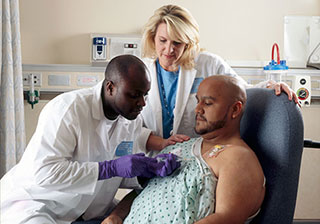| The following article features coverage from the 2017 Oncology Nursing Society’s Annual Conference in Denver, Colorado. Click here to read more of Oncology Nurse Advisor‘s conference coverage. |
Daily CHG bathing can safely reduce CLABSIs in oncology patients with central lines, with small variations in efficacy of the practice due to differences in patient population, work processes, and team engagement, according to a presentation at the 2017 Oncology Nursing Society Annual Congress.
An estimated 250,000 central line-associated blood stream infections (CLABSIs) occur in patients with central lines each year. CLABSI costs $16,000 to $29,000 per infection, result in an extra 24 days in hospital, and has a mortality rate of 35%.
Bathing patients with central lines daily with 2% chlorhexidine gluconate (CHG) is proven to reduce CLABSIs by 25% to 75%. However, most research on this effect has been conducted in the intensive-care setting; data involving oncology populations is limited, reported Laura A. Johnson, MSN, RN, BMTCN, of The University of Chicago Medicine in Chicago.
Therefore, Ms Johnson and colleagues sought to reduce CLABSI occurrence on 2 adult oncology units at their facility: solid tumor (Unit 1) and hematology-oncology/stem cell transplant (Unit 2). To do this, they conducted an evidence-based practice (EBP) project in which patients with a central line were bathed daily using CHG wipes.
The researchers conducted a literature review of the effectiveness of daily CHG wipes in reducing CLABSIs and successful implementation of a quality improvement project. The researchers then designed a multifaceted plan that included a champion team, staff education, and patient education and instructions.
Concerns regarding skin sensitivity prompted an initial trial of twice weekly CHG bathing of patients on the 2 units. Bath completion audits were conducted twice a week to monitor adherence to the project. Audit results, CLABSI occurrences, and barriers to bath completion were discussed at staff huddles and meetings. The champion team held meetings to discuss results weekly.
In the 4 months prior to implementation of the EBP project, CLABSI rates were 0.44 per 1000 central-line days (1 CLABSI) on Unit 1 and 3.18 per 1000 central-line days (7 CLABSIs) on Unit 2.
Bath completion audits in the first month revealed adherence rates of 60% and 49%, respectively, on Unit 1 and Unit 2. Audits conducted in the 4 months after implementation indicated that on both units adherence rates increased (88% on Unit 1, 78% on Unit 2), and CLABSI rates declined to 0 (0 CLABSIs on Unit 1) and 1.90 (5 CLABSIs on Unit 2).
Variations in results between the 2 units were likely due to differences in patient population, work processes, and team engagement. Patients on Unit 2, where adherence was slightly lower, were more immunocompromised, had more complex patient factors, and were at greater risk for infection.
This EBP project demonstrated that daily CHG bathing can safely reduce CLABSIs in patients with central lines, the researchers conclude. Therefore, daily CHG bathing will be continued in oncology patients at The University of Chicago Medicine. The researchers note, however, that further research is needed to determine if these findings can be generalized to all oncology patients.
Read more of Oncology Nurse Advisor‘s coverage of the 2017 Oncology Nursing Society’s Annual Conference by visiting the conference page.
Reference
1. Johnson L, Hensley R, Beschorner J, Noginskaya V, Hagens E. Does chlorhexidine bathing reduce central line-associated bloodstream infections? Oral presentation at: Oncology Nursing Society 42nd Annual Congress; May 4-7, 2017; Denver, CO.
